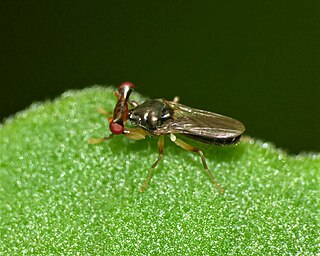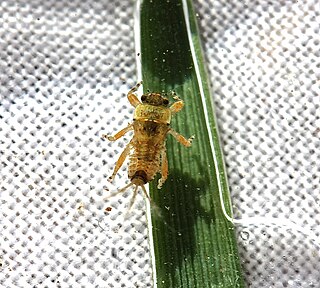
Lampyris is a genus of beetles in the Lampyridae. In most of western Eurasia, they are the predominant members of this family and includes the European common glow-worm, which is the type species. They produce a continuous glow; the larvae and larviform females are among those organisms commonly called "glowworms".

The Coelopidae or kelp flies are a family of Acalyptratae flies, they are sometimes also called seaweed flies, although both terms are used for a number of seashore Diptera. Fewer than 40 species occur worldwide. The family is found in temperate areas, with species occurring in the southern Afrotropical, Holarctic, and Australasian regions.

Hybotidae, the typical dance flies, are a family of true flies. They belong to the superfamily Empidoidea and were formerly included in the Empididae as a subfamily.

Athericidae is a small family of flies known as water snipe flies or ibis flies. They used to be placed in the family Rhagionidae, but were removed by Stuckenberg in 1973. They are now known to be more closely related to Tabanidae. Species of Athericidae are found worldwide.

Petrophora is a genus of moths in the family Geometridae erected by Jacob Hübner in 1811.
Platylomia is a genus of cicadas from Southeast Asia.

The Syrphini are a tribe of hoverflies.

Sphyracephala is a genus of stalk-eyed flies in the family Diopsidae, with records from Africa, Europe, Asia and N. America.

Platystomatinae is a subfamily of flies (Diptera) in the family Platystomatidae that includes 80 genera, the largest subfamily with at last estimate, c. 900 species globally.

Loxocera is a genus of flies and member of the family Psilidae.

Loxocera aristata is a species of fly and member of the family Psilidae.

Pentatomini is a tribe of shield bugs in the subfamily of Pentatominae.
The Cremifaniidae are a very small family of acalyptrate flies with only 4 described species worldwide. All species are considered rare, and nothing is known of their life history. They were formerly placed in the family Chamaemyiidae.
Ortalis is an historic genus of Ulidiid or picture-winged flies, first described by Fallén in 1810. It served as the type genus for the family Ulidiidae, which was called Ortalidae at the time. In 1932, it was pointed out by Adlrich that the name Ortalis was preoccupied by a genus of birds which had been named by Merrem in 1786. The name of the fly family was therefore revised, with some authors calling it Otitidae until Ulidiidae was settled on as standard. The genus itself was found to be paraphyletic, and all of its species have been reassigned to other genera, some in the Ulidiidae, and some in other Tephritoid families. In the following list, the species are organized according to the families and genera to which they have been reassigned.
Adelius is a genus of parasitoid wasps in the family Braconidae, first described in 1833 by Alexander Henry Haliday.

Ephemerella is a genus of spiny crawler mayflies in the family Ephemerellidae with a widespread distribution.

Podopinae, known as turtle bugs, are a subfamily of the insect family Pentatomidae. The type genus is Podops.

Prostemma is a genus of bugs in the family Nabidae, subfamily Prostemmatinae and tribe Prostemmatini.
Pachycoleus is a genus of bugs in the family Dipsocoridae, erected by Franz Xaver Fieber in 1860. The type species Pachycoleus waltli is recorded from northern Europe including the British Isles.

Brachycarenus is a genus of bugs in the family Rhopalidae and the tribe Rhopalini, erected by Franz Xaver Fieber in 1860. The species Brachycarenus tigrinus is recorded from much of Europe ; the British Isles, where it was a fairly recent (2003) introduction.













